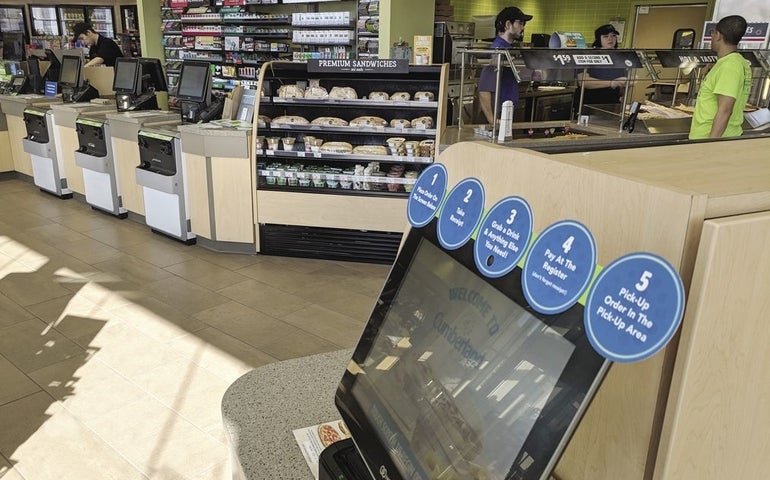Convenience stores have long wanted to draw people pumping gas to also pick up a gallon of milk, a loaf of bread or maybe a coffee and a snack.
Cumberland Farms now wants customers to stay while, with new menus featuring more elaborate sandwiches and coffee offerings going well beyond the Westborough company’s 99-cent coffee mainstay, and plenty of space for customers to fix their own drinks, add condiments or place orders at kiosks.
In short, Cumberland Farms doesn’t want someone popping in for a bag of chips. It now wants someone to grab a spinach-and-feta sandwich or a macchiato.
“It is a significant investment,” said David Heilbronner, the company’s director of brand strategy and advertising. “It’s worth it for us.”
The latest move by Cumberland Farms – unveiled in a store opened last month on East Main Street in Westborough – continues a widespread remodeling of stores begun roughly a decade ago. Those stores brought the first use of a bright green-and-blue logo and more modern stores with vaulted ceilings to nearly all of 600 locations.
The company now has added self-serve ordering terminals, upgraded a line of grab-and-go meals to include meatball sandwiches, egg-and-chorizo wraps, and a range of smoothies.
“It’s more getting into the food business, or like a quick-service restaurant,” Heilbronner said.
Not a joke anymore
Cumberland Farms is making a foray into relatively more upscale dining as industry trends change both for fast-casual dining and the grocery business.
On one end, the grocery industry is evolving with delivery services such as Instacart and a planned foray into the brick-and-mortar business from online retail giant Amazon. On the other, more professionals choosing to work from home has meant less of a need to fill up on gas and stop in for other purchases.
[Related: Cumberland Farms reportedly eyeing sale that would end eight decades of family ownership]
Jeff Lenard, the vice president for strategic industry initiatives for the Virginia-based National Association of Convenience Stores, thinks back to the 1983 comedy “National Lampoon’s Vacation.” Clark Griswold, played by Chevy Chase, gave the industry a pointed dig while behind the wheel.
“I’m so hungry I could eat a sandwich from a gas station,” he tells his family.
Lenard sees the industry as having evolved past that point.
“What Cumberland Farms and others are doing is making that laugh line non-existent now,” Lenard said.
Cumberland Farms, a privately-held firm that opened its first store in 1957 in Bellingham, isn’t alone in moving toward higher-end options, bigger stores and more personalized choices.
The Texas-based chain Stripes has its own taco line, Laredo Taco Co., in more than 450 of its roughly 700 locations. Georgia-based RaceTrac has self-serve ice cream, yogurt and other frozen treats. Pennsylvania-based Wawa is known widely for its freshly made sandwiches.
New stores today are larger than ever, many more than 4,000 square feet, to make enough room for prepared and packaged sandwiches, pizzas and other fare, the Chicago-based analyst NRC Realty & Capital Advisors said in a report in January. The new Cumberland Farms store in Westborough is nearly 5,300 square feet.
“There’s so much competition out there, and we have to be able to compete,” said Heilbronner, the Cumberland Farms executive. “It’s a big opportunity that we probably haven’t leveraged in the past.”
Quality, cost & speed
Across the industry, the main difference between top performers and laggards is the growth of food service looking more like a restaurant, Lenard said.
That doesn’t mean convenience stores aren’t still worried about speed. An average customer is in and out in just four minutes, Lenard said. And while prices are higher for some items — like $4.99 for an Italian ciabatta sandwich or $2.69 for a cappuccino or latte — Cumberland Farms still keeps items cheaper than at, say, the fast-casual chain Panera Bread.
Nearly a decade after unveiling 99-cent coffee, for example, that price still stands.
A lot else has changed, though. Kiosks are set up for ordering sandwiches if someone wants an option not already available to take, or for a freshly made latte. Traditional aisles are laid out across less than half the store’s interior space, with much more room for grabbing coffee. Three self-checkout stations line the counter near the front door.
Cumberland Farms and its competitors are searching for the best way to keep customers when fewer may have reason to come in the door. Cars are generally more fuel efficient than in past generations or run on battery, making gas stops less frequent or unnecessary. And when fewer people are driving to a shopping mall for purchases because they’re shopping online, that leaves fewer vehicle trips for a stop at a convenience store to or from home.
Only one out of five customers said they went to a convenience store during a trip for that singular purpose, according to a National Association of Convenience Stores annual report released in April.
“The convenience store industry is facing a lot of challenges,” said David Feit, a vice president for strategic insights for the industry analyst the Hartman Group in Washington. “It’s not too dissimilar to what’s happening with other industries.”
Industry research has shown customers evolving in their idea of convenience, Feit said. Today, the concept in food is more likely to prioritize personalization or something unique. In past years, he said, there was a trade-off between cost, speed and quality. Now, fast-casual restaurants are more widespread, healthier and with higher-quality choices.
If convenience stores can’t rely so much on gas fill-ups, better food options can become a stronger draw, Feit said.
“You have to find other ways to bring people in,” he said.

